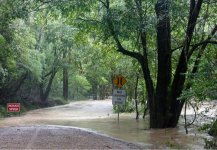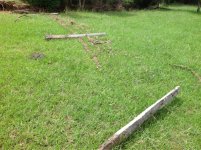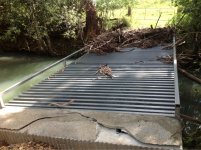I replaced the bridge on my 100 acre farm a year or so ago.
The new bridge was placed on a concrete section of roadway that was built about 20 years ago. I then built the roadway up to the new bridge. The original plan was to position the bridge on a new location higher above the water, but on the day excavator was booked along with a bunch of friends to help, the excavator didn't arrive and I had to use the location of the bridge that was being replaced.
A few weeks back we had a one in a 100 year flood with 30 inches of rain in just 3 days. Even though the bridge was submerged by the torrent, it survived unscathed. Unfortunately part of the concrete base was undermined and collapsed.
After much deliberation the "simplest" option seemed to be to shift the bridge to a new location only 20 metres or so away where the banks of the creek were much higher. The was an old timber and earth bridge there that had partially collapsed so that had to be removed first.
I put in some new footings for the bridge and some rock baskets at the base of the bank most susceptible to washout. Only one sentence but a few weekends work including hiring an excavator.
The big question now was to work out how heavy the bridge was. A bit of research came up with the weights of various sorts of timber and the calculations were done. 40 foot long and I estimated the bridge at 6 tons.
The property is 40 minutes from the nearest town with a crane for rent, along some very windy dirt roads. The crane operator insisted on visiting the property first to see that it was feasible and then gave me the quote. So much for a holiday this year....
On the day it happened remarkably quickly. The slowest process was levelling the crane on the sloping ground. They had brought a sling to fit under under the bridge and after a bit of jiggling to get it balanced, it slowly lifted from its footings. It's weight was only 5 ton so I was on the right side for safety.
We had trimmed some trees to make the swing into its new location more straightforward and within 10 minutes it was sitting perfectly.
Many tons of road base later the roadway was level with the bridge.
We've since had another heavy rain event with moderate flooding and the water missed the bridge by a few feet so I'm much happier with the new location.
Major job but very satisfying.
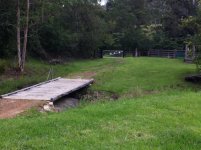
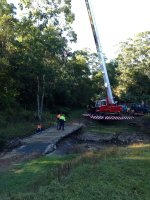
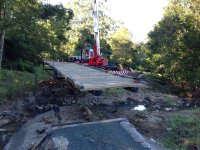
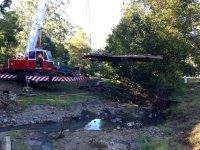
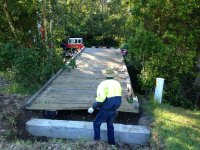
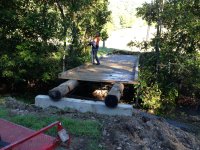
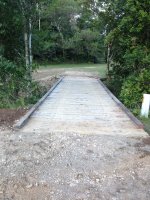
The new bridge was placed on a concrete section of roadway that was built about 20 years ago. I then built the roadway up to the new bridge. The original plan was to position the bridge on a new location higher above the water, but on the day excavator was booked along with a bunch of friends to help, the excavator didn't arrive and I had to use the location of the bridge that was being replaced.
A few weeks back we had a one in a 100 year flood with 30 inches of rain in just 3 days. Even though the bridge was submerged by the torrent, it survived unscathed. Unfortunately part of the concrete base was undermined and collapsed.
After much deliberation the "simplest" option seemed to be to shift the bridge to a new location only 20 metres or so away where the banks of the creek were much higher. The was an old timber and earth bridge there that had partially collapsed so that had to be removed first.
I put in some new footings for the bridge and some rock baskets at the base of the bank most susceptible to washout. Only one sentence but a few weekends work including hiring an excavator.
The big question now was to work out how heavy the bridge was. A bit of research came up with the weights of various sorts of timber and the calculations were done. 40 foot long and I estimated the bridge at 6 tons.
The property is 40 minutes from the nearest town with a crane for rent, along some very windy dirt roads. The crane operator insisted on visiting the property first to see that it was feasible and then gave me the quote. So much for a holiday this year....
On the day it happened remarkably quickly. The slowest process was levelling the crane on the sloping ground. They had brought a sling to fit under under the bridge and after a bit of jiggling to get it balanced, it slowly lifted from its footings. It's weight was only 5 ton so I was on the right side for safety.
We had trimmed some trees to make the swing into its new location more straightforward and within 10 minutes it was sitting perfectly.
Many tons of road base later the roadway was level with the bridge.
We've since had another heavy rain event with moderate flooding and the water missed the bridge by a few feet so I'm much happier with the new location.
Major job but very satisfying.








